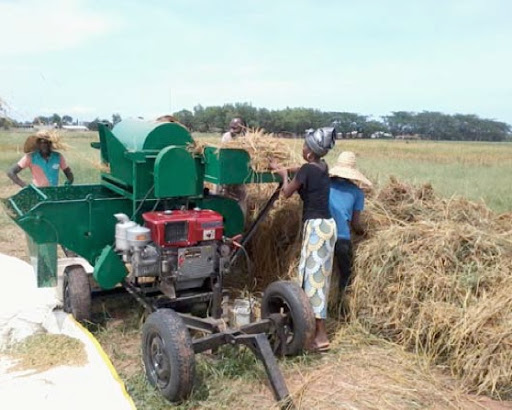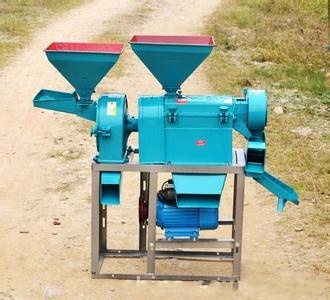Axial flow thresher and improved quality polishing
Summary
Threshing is the process of separating rice grain from the chaff that surrounds it, and polishing is where the outermost bran layers are removed. Both these operations are of great importance to enhance the cooking quality and palatability of rice which pushes up its value when sold on markets. Most rice farmers in Sub-Saharan Africa use traditional methods where the panicles are treaded on by humans or animals for threshing, leading to high losses as a result of grain breakage. Manual polishing is done by soaking the kernels in water and rubbing them against each other to peel off the brans. These artisanal practices take up a lot of time and labour making it impossible to process the large volumes of rice that are harvested in communities, thus missing out on value add. Mechanized equipment for threshing and polishing have existed for a long time but are little adopted across rice growing areas of SSA because of the capital investment that is needed and also low performance levels when it is not configured well.
About the Solution
Modern, motorized axial flow threshers use a turning drum in which rice moves between the concave and rotating drum for several complete turns causing multiple impacts as the produce moves along the length of the drum. Rice husks are fully removed and grains cleaned through a set of separation sieves and a blower or aspirator. The drum is the core working device of a thresher and its configuration has a major influence on the energy efficiency, power requirement and seed loss of the process. Mechanical rice polishers are abrasive machines that use talc or some other very fine dust to buff the outer surface of rice kernels. The process of polishing removes the fibrous bran layer and leaves behind the starch-rich grain making the rice easier to cook and giving it a more delicate taste. Self-contained mobile motorized threshers and polishers for rice are available from agricultural equipment manufacturers that can be brought close to the paddy fields of farmers and allow processing large volumes of high-quality grain while keeping costs low. Compact diesel/petrol generators and solar panel installations are used in mobile units to supply power for threshing and polishing of rice, making it easy to operate in expansive rice growing areas.
Motorized axial-flow threshers and abrasive polishers offer major practical and economic advantages for post-harvest value addition in all major rice production zones of SSA, both at subsistence and commercial scale. The high degree of mobility and cost-effectiveness achieved by mobile rice processing units make it very suitable for regions where processing factories are few, and road and electricity infrastructures fall short, like is the case in many of the continent’s rural regions. Sizes and configurations of the equipment outfits can be easily adapted to different contexts and objectives of rice farmers, making it possible to bring the modern mechanized technologies for threshing and polishing to any community in SSA.
Longitudinal axial flow threshing drums are made of a long cylinder with spikes or rasp bars on its inner surface, a thresher with spike teeth, a thresher cover with helical blades, and a stationary concave that is perforated to enable the product to drop by gravity into a collector. Rotational speeds of the thresher are conveyed from the engine using a pulley and belt. Abrasive polishers exist of a moving stone or carborundum type sufarce and stationary screen that are usually vertical cone-shaped, whereas friction polishers have a steel-ribbed cylinder rotating inside a metal-plated cylinder that are mounted horizontally. Automated polishers can also be fitted with a water spraying system for high gloss finishes. The key parts of threshers and polishers are made of stainless steel that make it long-lasting and easy to keep in hygienic conditions.
Threshing of rice is normally done when the grain moisture content is 15 to 17%, if it is higher or lower the efficiency goes down, and grain damage and loss increase. Rotational speeds of thresher can be changed according to the desired rate of processing and power consumption, but have to be optimized to avoid cracking of grains and incomplete removal of husks. Maximum threshing productivity and efficiency are achieved at higher rotational speeds and feed-in rates, whereas minimum power is used for threshing rice when rotating speeds and feed-in rates are lower. Trailer-mounted thresher units powered by a 18-24 horsepower motor have a rice haulm/stover in-take capacity of 2 ton per hour and unhusked grain output rate of 0.5-0.75 ton per hour. For polishing, the rotational speed of the cylindrical chamber and roller wheel have to be sufficiently high to achieve satisfactory productivity and quality, but not too fast as that causes grain breakage and loss. The processing capacity of polishers goes from 50-100 kg per hour for smaller bench-top systems, to 300-500 kg per hour for larger trailer-sized systems. It is possible for local artisans to fabricate motorized units for threshing and polishing since all building materials and equipment are readily accessible to rural communities in African countries.
Commercialization
Commercially available
Solution Images
Institutions



